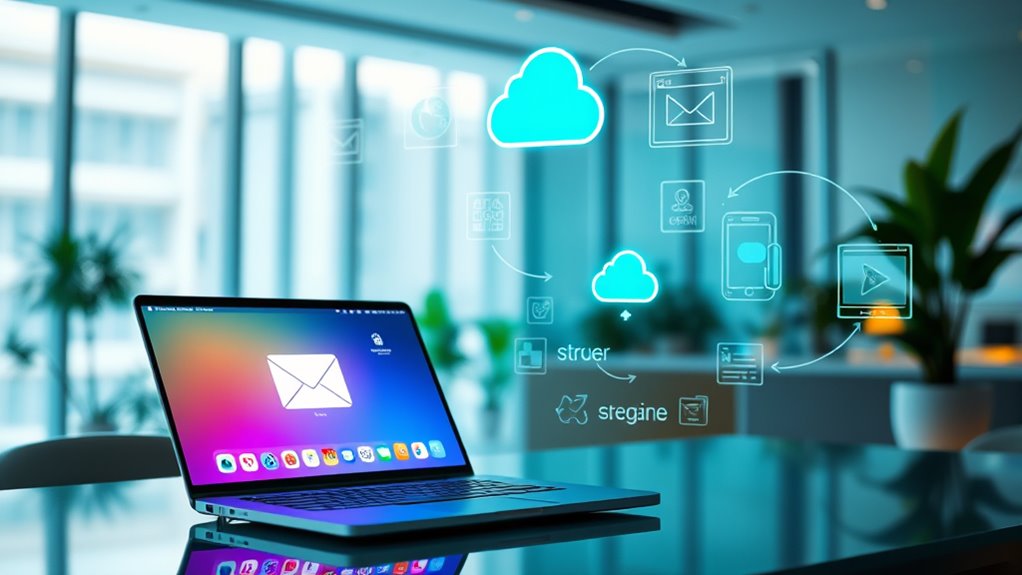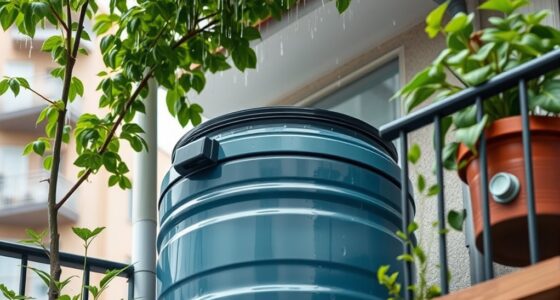Every email you send, especially with attachments, adds to your digital carbon footprint by using energy in data centers and servers. Streaming videos, particularly in high resolution, demands lots of data transfer and computational power, increasing energy use. Storing files in the cloud also consumes significant power, depending on the data center’s energy sources. To minimize your impact, consider offline options and mindful storage habits—if you want to discover simple ways to reduce your digital footprint, stick with this guide.
Key Takeaways
- Sending unnecessary emails and large attachments increase data storage and energy consumption in data centers.
- Streaming high-definition videos demands significant bandwidth and computational power, raising digital carbon footprints.
- Cloud storage relies on energy-intensive data centers, especially if stored files are large or rarely accessed.
- Using offline content and lower-resolution streams can substantially reduce energy use and environmental impact.
- Choosing renewable-powered cloud providers and regularly cleaning stored files help minimize digital environmental footprints.

In today’s digital age, your online activities contribute to a surprisingly notable environmental impact known as your digital carbon footprint. Every time you send an email, stream a show, or save files to the cloud, you’re indirectly supporting data storage and the energy-intensive infrastructure that powers it. Data storage, especially in data centers, consumes vast amounts of electricity to keep servers running and cool. When you upload or download files, stream videos, or back up information, you’re adding to the demand for these energy-hungry facilities. Streaming services, which have become a staple of entertainment, are particularly resource-intensive. Each second of a high-definition video you watch requires data to be transmitted from servers to your device, demanding considerable computational power and network bandwidth. The more you stream, the greater the energy consumption, contributing to your digital carbon footprint.
Your email habits also matter more than you might think. While individual messages may seem insignificant, millions of emails sent daily add up. Attachments, images, and lengthy threads require storage and transmission, all of which consume electricity. Deleting unnecessary emails can reduce storage needs, easing the load on data centers. Cloud storage, which many rely on for convenience, involves data centers spread around the globe. These centers operate 24/7, often powered by a mix of renewable and non-renewable energy sources. The more you store on the cloud, especially large files or old backups, the more energy is needed to keep that data accessible. To lower your digital footprint, consider regularly cleaning out unnecessary files and choosing services committed to greener energy sources.
Being mindful of your streaming habits can also make a difference. Instead of binge-watching for hours on end, try to limit your viewing time or choose lower-resolution streams when possible. Watching in higher resolution significantly increases data transfer and storage demands. Opting for audio-only options or downloading content for offline viewing can further reduce the energy use associated with continuous streaming. When it comes to email, avoid unnecessary messages and large attachments. Use concise language, and delete emails you no longer need. For data storage, prefer local storage for files you rarely access, and be selective about what you upload to cloud services. Additionally, choosing providers that prioritize sustainable data centers can significantly decrease your online environmental impact.
Every small action you take influences your overall digital impact. By being conscious of how much data you generate, stream, and store, you can help reduce the energy demand of our digital infrastructure. Making smarter choices about your online activities isn’t just good for your digital life but also for the environment. Your efforts, combined with others’ mindful habits, can contribute to a more sustainable digital future.
Frequently Asked Questions
How Can I Measure My Personal Digital Carbon Footprint Accurately?
To measure your personal digital carbon footprint accurately, start by tracking your email volume, streaming hours, and cloud storage use. Use tools that incorporate data anonymization to protect your privacy while providing insights. Consider carbon offsetting options to balance out your digital activities’ impact. Regularly review your usage habits and opt for greener alternatives, like energy-efficient devices and cloud providers committed to renewable energy, to reduce your overall footprint.
What Are the Most Eco-Friendly Ways to Store Data in the Cloud?
You can store data eco-friendly by choosing providers that prioritize data center efficiency and use renewable energy sourcing. Opt for cloud services with high energy efficiency ratings, as they consume less power and reduce emissions. Support companies committed to renewable energy, ensuring your data is stored sustainably. Regularly delete unnecessary files to minimize storage needs, and consider local storage options when feasible to further reduce your digital carbon footprint.
How Does Streaming Quality Affect Energy Consumption?
Higher streaming quality requires more data transfer and less efficient video compression, which increases energy consumption. When you choose HD or 4K, your device uses more power to process and transmit larger files, leading to higher carbon emissions. To reduce your digital footprint, opt for lower resolutions or enable auto-quality adjustment, which balances viewing quality and energy use. This way, you help save energy and lessen environmental impact.
Are There Specific Email Practices That Reduce Carbon Emissions?
You can reduce your carbon emissions by practicing email efficiency and digital decluttering. Delete unnecessary emails, especially large attachments, to lighten server loads. Limit the number of emails you send and receive daily, and avoid long threads that keep multiple copies stored. Using email filters and unsubscribing from unwanted newsletters also helps. These habits cut down on energy consumption from data centers, making your digital life more eco-friendly.
What Future Technologies Might Lower Digital Carbon Footprints?
Your digital footprint could shrink dramatically with future tech. Artificial intelligence will optimize energy use, making processes more efficient and eco-friendly. Renewable data centers powered by wind and solar will cut emissions considerably. Imagine a world where every email, stream, and cloud storage leaves a tiny, almost negligible mark on the planet. These innovations are on the horizon, promising a future where digital life and sustainability go hand in hand, saving our planet.
Conclusion
As you scroll through your emails, stream your favorite shows, and store files in the cloud, you’re painting a digital landscape with every click. Coincidentally, each action adds a tiny footprint—like footprints in fresh snow—forming a larger picture of your carbon impact. By being mindful, you can reduce this digital trail. Think of it as walking softly on the snow, leaving fewer marks behind, and helping to protect our planet’s delicate balance.








